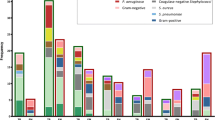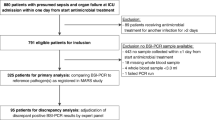Abstract
Early detection of bloodstream infections (BSI) is crucial in the clinical setting. Blood culture remains the gold standard for diagnosing BSI. Molecular diagnostic tools can contribute to a more rapid diagnosis in septic patients. Here, a multiplex real-time PCR-based assay for rapid detection of 25 clinically important pathogens directly from whole blood in <6 h is presented. Minimal analytical sensitivity was determined by hit rate analysis from 20 independent experiments. At a concentration of 3 CFU/ml a hit rate of 50% was obtained for E. aerogenes and 100% for S. marcescens, E. coli, P. mirabilis, P. aeruginosa, and A. fumigatus. The hit rate for C. glabrata was 75% at 30 CFU/ml. Comparing PCR identification results with conventional microbiology for 1,548 clinical isolates yielded an overall specificity of 98.8%. The analytical specificity in 102 healthy blood donors was 100%. Although further evaluation is warranted, our assay holds promise for more rapid pathogen identification in clinical sepsis.




Similar content being viewed by others
References
Struelens MJ, de Mendonca R (2001) The emerging power of molecular diagnostics: towards improved management of life-threatening infection. Intensive Care Med 27(11):1696–1698
Harbarth S, Garbino J, Pugin J, Romand JA, Lew D, Pittet D (2003) Inappropriate initial antimicrobial therapy and its effect on survival in a clinical trial of immunomodulating therapy for severe sepsis. Am J Med 115(7):529–535
Wellinghausen N, Wirths B, Franz AR, Karolyi L, Marre R, Reischl U (2004) Algorithm for the identification of bacterial pathogens in positive blood cultures by real-time LightCycler polymerase chain reaction (PCR) with sequence-specific probes. Diagn Microbiol Infect Dis 48(4):229–241
Ibrahim EH, Sherman G, Ward S, Fraser VJ, Kollef MH (2000) The influence of inadequate antimicrobial treatment of bloodstream infections on patient outcomes in the ICU setting. Chest 118(1):146–155
Morrell M, Fraser VJ, Kollef MH (2005) Delaying the empiric treatment of candida bloodstream infection until positive blood culture results are obtained: a potential risk factor for hospital mortality. Antimicrob Agents Chemother 49(9):3640–3645
Garnacho-Montero J, Garcia-Garmendia JL, Barrero-Almodovar A, Jimenez-Jimenez FJ, Perez-Paredes C, Ortiz-Leyba C (2003) Impact of adequate empirical antibiotic therapy on the outcome of patients admitted to the intensive care unit with sepsis. Crit Care Med 31(12):2742–2751
Davis TE, Fuller DD (1991) Direct identification of bacterial isolates in blood cultures by using a DNA probe. J Clin Microbiol 29(10):2193–2196
Carroll KC, Leonard RB, Newcomb-Gayman PL, Hillyard DR (1996) Rapid detection of the staphylococcal mecA gene from BACTEC blood culture bottles by the polymerase chain reaction. Am J Clin Pathol 106(5):600–605
Jansen GJ, Mooibroek M, Idema J, Harmsen HJ, Welling GW, Degener JE (2000) Rapid identification of bacteria in blood cultures by using fluorescently labeled oligonucleotide probes. J Clin Microbiol 38(2):814–817
Jordan JA, Durso MB (2000) Comparison of 16S rRNA gene PCR and BACTEC 9240 for detection of neonatal bacteremia. J Clin Microbiol 38(7):2574–2578
Kempf VA, Trebesius K, Autenrieth IB (2000) Fluorescent in situ hybridization allows rapid identification of microorganisms in blood cultures. J Clin Microbiol 38(2):830–838
Laforgia N, Coppola B, Carbone R, Grassi A, Mautone A, Iolascon A (1997) Rapid detection of neonatal sepsis using polymerase chain reaction. Acta Paediatr 86(10):1097–1099
Newcombe J, Cartwright K, Palmer WH, McFadden J (1996) PCR of peripheral blood for diagnosis of meningococcal disease. J Clin Microbiol 34(7):1637–1640
Shang S, Chen Z, Yu X (2001) Detection of bacterial DNA by PCR and reverse hybridization in the 16S rRNA gene with particular reference to neonatal septicemia. Acta Paediatr 90(2):179–183
Yang S, Lin S, Kelen GD, Quinn TC, Dick JD, Gaydos CA, Rothman RE (2002) Quantitative multiprobe PCR assay for simultaneous detection and identification to species level of bacterial pathogens. J Clin Microbiol 40(9):3449–3454
Biedenbach DJ, Moet GJ, Jones RN (2004) Occurrence and antimicrobial resistance pattern comparisons among bloodstream infection isolates from the SENTRY antimicrobial surveillance program (1997–2002). Diagn Microbiol Infect Dis 50(1):59–69
Wisplinghoff H, Bischoff T, Tallent SM, Seifert H, Wenzel RP, Edmond MB (2004) Nosocomial bloodstream infections in US hospitals: analysis of 24,179 cases from a prospective nationwide surveillance study. Clin Infect Dis 39(3):309–317
Louie M, Louie L, Simor AE (2000) The role of DNA amplification technology in the diagnosis of infectious diseases. CMAJ 163(3):301–309
Sleigh J, Cursons R, La Pine M (2001) Detection of bacteraemia in critically ill patients using 16S rDNA polymerase chain reaction and DNA sequencing. Intensive Care Med 27(8):1269–1273
Klaschik S, Lehmann LE, Raadts A, Book M, Gebel J, Hoeft A, Stuber F (2004) Detection and differentiation of in vitro-spiked bacteria by real-time PCR and melting-curve analysis. J Clin Microbiol 42(2):512–517
Seifert H (2001) MiQ: qualitätsstandards in der mikrobiologisch-infektiologischen diagnostik; Heft 3: Sepsis-Blutkulturdiagnostik. Elsevier, Urban and Fischer
Wellinghausen N, Wirths B, Essig A, Wassill L (2004) Evaluation of the hyplex bloodscreen multiplex PCR-enzyme-linked immunosorbent assay system for direct identification of Gram-positive cocci and Gram-negative bacilli from positive blood cultures. J Clin Microbiol 42(7):3147–3152
Meier A, Persing DH, Finken M, Bottger EC (1993) Elimination of contaminating DNA within polymerase chain reaction reagents: implications for a general approach to detection of uncultured pathogens. J Clin Microbiol 31(3):646–652
Corless CE, Guiver M, Borrow R, Edwards-Jones V, Kaczmarski EB, Fox AJ (2000) Contamination and sensitivity issues with a real-time universal 16S rRNA PCR. J Clin Microbiol 38(5):1747–1752
Klaschik S, Lehmann LE, Raadts A, Hoeft A, Stuber F (2002) Comparison of different decontamination methods for reagents to detect low concentrations of bacterial 16S DNA by real-time-PCR. Mol Biotechnol 22(3):231–242
Gurtler V, Stanisich VA (1996) New approaches to typing and identification of bacteria using the 16S-23S rDNA spacer region. Microbiology 142(Pt 1):3–16
Barry T, Glennon CM, Dunican LK, Gannon F (1991) The 16s/23s ribosomal spacer region as a target for DNA probes to identify eubacteria. PCR Methods Appl 1(2):149
Werner AS, Cobbs CG, Kaye D, Hook EW (1967) Studies on the bacteremia of bacterial endocarditis. JAMA 202(3):199–203
Kreger BE, Craven DE, Carling PC, McCabe WR (1980) Gram-negative bacteremia. III. Reassessment of etiology, epidemiology and ecology in 612 patients. Am J Med 68(3):332–343
Weinstein MP, Towns ML, Quartey SM, Mirrett S, Reimer LG, Parmigiani G, Reller LB (1997) The clinical significance of positive blood cultures in the 1990s: a prospective comprehensive evaluation of the microbiology, epidemiology, and outcome of bacteremia and fungemia in adults. Clin Infect Dis 24(4):584–602
Kumar A, Roberts D, Wood KE, Light B, Parrillo JE, Sharma S, Suppes R, Feinstein D, Zanotti S, Taiberg L, Gurka D, Kumar A, Cheang M (2006) Duration of hypotension before initiation of effective antimicrobial therapy is the critical determinant of survival in human septic shock. Crit Care Med 34(6):1589–1596
Author information
Authors and Affiliations
Corresponding author
Additional information
Lutz Eric Lehmann and Klaus-Peter Hunfeld contributed equally to this work.
Rights and permissions
About this article
Cite this article
Lehmann, L., Hunfeld, KP., Emrich, T. et al. A multiplex real-time PCR assay for rapid detection and differentiation of 25 bacterial and fungal pathogens from whole blood samples. Med Microbiol Immunol 197, 313–324 (2008). https://doi.org/10.1007/s00430-007-0063-0
Received:
Published:
Issue Date:
DOI: https://doi.org/10.1007/s00430-007-0063-0




